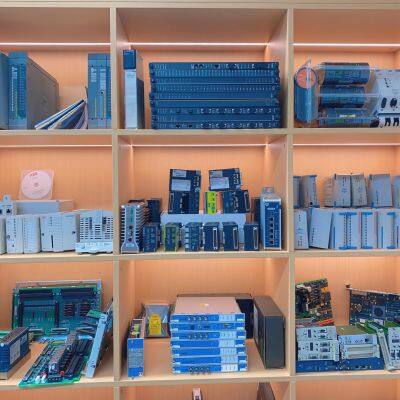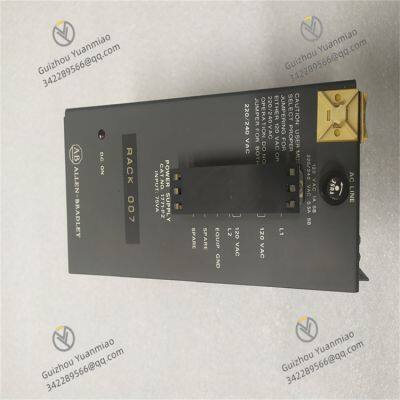Product Description
I. Product Overview
Allen - Bradley 1771 - P2 is an auxiliary power supply module specially designed for industrial automation control systems. It belongs to the Allen - Bradley PLC - 5 series of products and plays a key role in ensuring power supply in the entire automation system. Its main responsibility is to convert the externally input alternating current into stable direct current, providing reliable power support for equipment such as 1771 series I/O enclosures and specific processors, ensuring that all components of the system can operate stably and efficiently in complex industrial environments.
From the perspective of hardware architecture, this module adopts advanced power conversion technology, with built - in high - performance conversion chips and filter circuits. It can effectively cope with fluctuations and interference of the power grid voltage, ensuring the stability and purity of the output voltage. Its internal circuit layout is compact and reasonable, and various functional modules work together to achieve efficient power conversion and precise current control. At the same time, in order to ensure the reliability of the module in harsh industrial environments, the 1771 - P2 fully considers factors such as heat dissipation and anti - interference in its design. Through reasonable heat dissipation structures and electromagnetic shielding measures, it reduces the impact of environmental factors on the module's performance.
In terms of structural design, the 1771 - P2 adopts a standardized module shape, with dimensions of 116 mm × 286 mm × 182 mm (4.56 inches × 11.25 inches × 7.16 inches). This compact design allows it to be easily installed in industrial control cabinets and work in coordination with other equipment. The module shell is made of strong and durable metal materials, with good impact resistance and vibration resistance. It can adapt to the mechanical environment of industrial sites, effectively protect internal circuit components, and extend the service life of the module.

II. Performance Parameters
(1) Electrical Characteristics
Input Power Supply: It supports a wide range of AC input voltages, which can be adapted to three common power grid voltage standards: 120V AC, 220V AC, and 240V AC. When the input voltage is 120V AC, the rated input current is 0.75A; when the input voltage is 220 - 240V AC, the rated input current is 0.38A. The normal working range of the input voltage is between 98 - 132V AC (corresponding to 120V AC input) and 196 - 250V AC (corresponding to 220 - 240V AC input), which can well adapt to the voltage fluctuations of power grids in different regions. The frequency adaptation range of this module is 50/60Hz, with strong versatility.
Output Power Supply: The main output is a stable DC voltage of 5.1V DC, with a maximum output current of 6.5A, which can meet the power supply needs of various industrial equipment. This output specification is particularly suitable for providing power to 1771 series I/O enclosures (which need to be equipped with adapter modules), and can also be used to power 1772 mini - PLC - 2 processors or 1772 mini - PLC - 2/15 processors. Under full load conditions, the maximum actual input power of the module is 65W, which can efficiently convert the input electrical energy into stable output DC power, providing reliable power protection for load equipment.
Protection Function Parameters: To ensure the safe operation of the module itself and the connected equipment, the 1771 - P2 has built - in perfect protection circuits. On the input side, overcurrent protection is realized through a fuse. When using 120V AC input, it is factory - equipped with a fuse with a rated current of 1A to protect the module from excessive current impact; if it is planned to use 230V AC (belonging to the 220 - 240V AC range) power input, the fuse needs to be replaced with a model with a rated current of 0.5A to meet the overcurrent protection needs under different input voltages. In addition, the output end of the module is also equipped with overvoltage and undervoltage monitoring circuits, which can monitor the output voltage status in real - time. Once the output voltage is abnormal, such as overvoltage or undervoltage, the monitoring circuit will act quickly and take corresponding protection measures, such as cutting off the output or adjusting the output voltage, to avoid damage to the backend load equipment.
(2) Interface Characteristics
Power Input Interface: It is equipped with a standard AC power input interface, which is compatible with AC power plugs of different specifications, and the connection method is simple and reliable. The interface is designed with clear marks, which is convenient for users to correctly connect the power cord and avoid equipment damage or safety accidents caused by wrong wiring. At the same time, there is enough space reserved around the interface to facilitate users' wiring operations and improve installation efficiency.
Power Output Interface: It is connected to the backplane of the 1771 series I/O enclosure through a dedicated cable (such as 1771 - CE or 1771 - CD cable) to provide stable DC power for each module in the enclosure. This backplane connection method not only simplifies the wiring structure of the system, reduces the clutter of cables, but also improves the stability and reliability of power transmission. The output interface adopts a reliable electrical connection design to ensure that the current can be transmitted stably during long - term use, providing continuous and stable power support for equipment such as I/O modules and processors.
(3) Environmental Adaptability
Operating Temperature: The operating temperature range of the module is 0°C to 60°C (32°F to 140°F), which can adapt to the temperature environment of most industrial production workshops. In high - temperature environments, through reasonable heat dissipation designs such as heat sinks, heat dissipation channels, and the efficient thermal conductivity of the metal shell, the module can timely dissipate the heat generated inside and maintain stable output performance; in low - temperature environments, the internal circuit is specially designed to start and run normally, ensuring the continuity of power supply and meeting the stable operation needs of industrial automation systems in different seasons and working environments.
Storage Temperature: In the storage state, the 1771 - P2 can withstand extreme temperatures from - 40°C to 85°C (- 40°F to 185°F). This feature enables it to maintain good performance under various complex transportation and storage conditions. Whether during transportation in cold winters or in high - temperature warehouse storage environments, the module can effectively resist the impact of temperature changes, ensuring that it can still be put into normal use after long - term storage, which provides great convenience for users.
Relative Humidity: The module can work normally in an environment with a relative humidity of 5% to 95% without condensation. This means it can adapt to humid industrial environments, such as textile factories, food processing plants and other places with high humidity, and will not cause short circuits or corrosion of internal circuits due to humidity problems, ensuring reliability and stability in various complex environments.

III. Functional Characteristics
(1) Stable and Reliable Power Conversion Function
The core function of the 1771 - P2 module is to achieve efficient and stable AC to DC power conversion. It can accurately convert the fluctuating AC input voltage into a stable 5.1V DC output. No matter how the external power grid voltage changes, it can always keep the accuracy of the output voltage within a very small error range. Even when the load current changes, the intelligent control circuit inside the module can respond quickly and automatically adjust the output to maintain the stability of the voltage, providing a solid power foundation for the connected equipment and ensuring that the normal operation of the equipment is not disturbed by power fluctuations.
(2) Perfect Protection Function
This module has perfect multiple protection functions, which is an important line of defense to ensure the safe operation of industrial automation systems. The overcurrent protection on the input side is realized through a fuse, which can effectively prevent damage to the internal circuit of the module due to excessive input current. The overvoltage and undervoltage monitoring circuits at the output end always monitor the output voltage status. Once an abnormality is detected, they immediately take protection measures, such as cutting off the output or adjusting the output voltage, to avoid damage to the backend load equipment. This all - round protection mechanism greatly improves the safety and reliability of the system and reduces the equipment downtime and maintenance costs caused by power supply failures.
(3) Status Indication Function
To facilitate users to know the operating status of the module in real - time, the 1771 - P2 is equipped with intuitive LED status indicators. When the module is normally connected to AC power and starts working, the power indicator will light up, clearly informing the user that the module is powered on. In addition, by monitoring the output voltage and current status, the module can also feed back output status information through specific indicators or signals. For example, when the output voltage or current is abnormal, the corresponding fault indicator will light up, reminding the user to check and deal with it in time. This intuitive status indication function greatly simplifies equipment maintenance work, improves the efficiency of fault diagnosis, and helps users quickly locate and solve problems.


Schneider TM251MESE Logic Controller
Schneider TM3AQ4 Output Module
Schneider TM3AI8 Analog Input Expansion Module
DEIF DLQ144-PC-NB Multi-Function Controller
VANGUARD PSMU-350-3 CPCI-350Q-P-38 Power Supply
Prosoft 202-DFNT-MCM4 Communications Module
Prosoft 5202-DFNT-MCM4 Communications Module
Emerson KJ4110X1-BA1 Programmable Logic Controller
ABB 1MRB15004R0001 Communication Module
ABB 1MRB150005R0001 Digital I/O Module
HIMA 80105 984080105 Communication Module
ABB 1MRK001967-AA Control Card
 yezi
Hi there! Welcome to my shop. Let me know if you have any questions.
yezi
Hi there! Welcome to my shop. Let me know if you have any questions.




